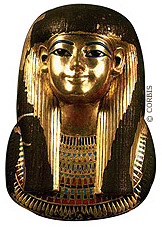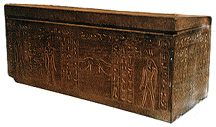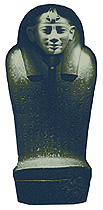|
|
Neferchichi's
Tomb
Funeral masks The Egyptians had yet another way to make sure the various forms of the spirit could recognize their own body. After the mummy was wrapped, a mask was fitted over the head and shoulders. The faces on these funeral masks resembled those of the dead, so the ba and ka could identify the mummy as their own. Funeral masks were made out of solid gold (like King Tut's), wood, or cartonnage (a material similar to paper-mâché). Wooden and cartonnage masks could be painted or gilded with gold- the look of solid gold at a fraction of the price!
To ensure a mummy's safety, an Egyptian embalmer placed it in one or more coffins. Like many other Egyptian burial customs, the styles of the coffins changed subtly over the thousands of years that mummification was practiced.

And for even more protection, some mummies were placed into a sarcophagus. A sarcophagus is a coffin made of stone or gold. Sarcophagi were expensive, so only pharaohs and queens, viziers, priests, and other important or wealthy people were buried in them. Like regular coffins, sarcophagi were either rectangular or mummiform.
|



 The
earliest coffins were boxy and made of wood. Their
decoration was usually very plain, with just some
hieroglyphs and a pair of wedjat eyes painted at
the head end. The wedjat eyes allowed the mummy to
"see" into the world of the living. As time passed,
the decoration became more elaborate. Images of
gods, hieroglyphs that spelled out protective
prayers, and pictures of amulets covered almost
every square inch of these coffins.
The
earliest coffins were boxy and made of wood. Their
decoration was usually very plain, with just some
hieroglyphs and a pair of wedjat eyes painted at
the head end. The wedjat eyes allowed the mummy to
"see" into the world of the living. As time passed,
the decoration became more elaborate. Images of
gods, hieroglyphs that spelled out protective
prayers, and pictures of amulets covered almost
every square inch of these coffins.

